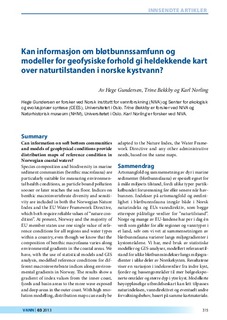| dc.description.abstract | Artsmangfold og sammensetning av dyr i marine sedimenter (bløtbunnsfauna) er spesielt egnet for å måle miljøets tilstand, fordi ulike typer partikkelbundet forurensning før eller senere når havbunnen. Indekser på artsmangfold og ømfintlighet i bløtbunnsfauna inngår både i Norsk naturindeks og EUs vanndirektiv, som begge etterspør pålitelige verdier for ”naturtilstand”. Norge og mange av EU-landene har per i dag én verdi som gjelder for alle regioner og vanntyper i et land, selv om vi vet at sammensetningen av bløtbunnsfauna varierer langs miljøgradienter i kystområdene. Vi har, med bruk av statistiske modeller og GIS-analyser, modellert referansetilstand for ulike bløtbunnsindekser langs miljøgradienter i ulike deler av Norskekysten. Resultatene viser en variasjon i indeksverdier fra indre kyst, fjorder og bassengområder til mer bølgeeksponerte områder og større dyp i ytre kyst. Modellerte høyoppløselige utbredelseskart kan lett tilpasses naturindeksen, vanndirektivet og eventuelt andre forvaltningsbehov, basert på samme kartmateriale. --- Can information on soft bottom communities and models of geophysical conditions provide distribution maps of reference condition in Norwegian coastal waters? Species composition and biodiversity in marine sediment communities (benthic macrofauna) are particularly suitable for measuring environmental health conditions, as particle bound pollution sooner or later reaches the sea floor. Indices on benthic macroinvertebrate diversity and sensitivity are included in both the Norwegian Nature Index and the EU Water Framework Directive, which both require reliable values of “nature condition”. At present, Norway and the majority of EU member states use one single value of reference conditions for all regions and water types within a country, even though we know that the composition of benthic macrofauna varies along environmental gradients in the coastal areas. We have, with the use of statistical models and GIS analysis, modelled reference conditions for different macroinvertebrate indices along environmental gradients in Norway. The results show a gradient of index values from the inner coast, fjords and basin areas to the more wave exposed and deep areas in the outer coast. With high resolution modelling, distribution maps can easily be adapted to the Nature Index, the Water Framework Directive and any other administrative needs, based on the same maps. | nb_NO |
